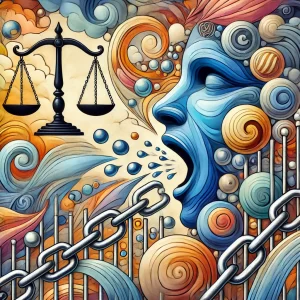Introduction
Recently, two important orders were passed concerning and relating to India TV, along with its chairman and editor-in-chief, Rajat Sharma. These rulings are significant for affirming the proprietary rights of news entities and the personal rights / protection of dignity of personalities. These decisions highlight the judiciary’s role in balancing the protection of individual personality rights, protection of dignity, and protection of proprietary rights with the fundamental right to freedom of speech.
- Independent News Service Private Ltd v. Ravindra Kumar Choudhary[i] (access link)
On 30th May 2024, the Delhi High Court issued an injunction against Mr. Ravindra Kumar Choudhary, a self proclaimed satirist. He had published various video and audio content on social media platforms parodying the India TV channel and its show “Aap Ki Adalat“.
The plaintiffs operating the news channel “INDIA TV” and holding registered trademarks for both “INDIA TV” and “AAP KI ADALAT“, had sought this injunction. The chairman and editor in chief of India TV, Rajat Sharma, raised concerns over Choudhary’s production and dissemination of content under the mark/logo “Baap Ki Adalat“, arguing that it closely resembled their own and caused public confusion, thereby infringing on their intellectual property rights.
The Court prevented the defendant from using the photos, videos, or name of the renowned journalist Rajat Sharma, in any capacity, including as a trademark, logo, trading style, domain name, social media post, or audio-video content, aiming to protect the personality rights of Rajat Sharma.
The Court also directed Choudhary to remove and refrain from using the names ‘Jhandiya TV’ and ‘Baap Ki Adalat‘, which were found to be deceptively similar to Sharma’s established news channel, India TV, and the widely popular show called ‘Aap Ki Adalat‘, in order to protect statutory and common law rights of the plaintiff.
In my opinion, even though the term ‘Jhandiya TV’ may seem like it was used in a satirical context, warranting protection under freedom of speech, a visual look at the manner in which this term was used, along with the design, makes it very easy to conclude that the intention of the creator was to deceive his viewers. The logos are extremely similar, if not almost same, and it is a fit case for injunction. The logo was as below:
However, in my opinion, to restrain the defendant from using the word “Baap Ki Adalat” as a parody seems a bit extreme. The term could be considered as an exercise of free speech. There may be adverse effects of this order, giving reason for various companies or personalities to restrict the freedom of speech of various online creators, who try to create satire and parodies in order to express themselves and their opinions.
- Rajat Sharma v. X Corp (Formerly Twitter)[ii] (judgement)
On 14th June, 2024, the Delhi High Court granted an ex-parte ad interim injunction and ordered certain videos and tweets to be removed from social media which were tarnishing the reputation of Rajat Sharma, while remarking that individual dignity and honour of a person cannot be allowed to be disreputed or defamed on the ground of right of free speech and expression.
Background
The series of events leading to the filing of the lawsuit began on June 4, 2024, during a live debate on India TV, anchored by the plaintiff, discussing the results of the Lok Sabha General Election, 2024. The defendant had expressed her views on the election results during this debate but did not object to any language used by Sharma or any other anchors.
Subsequently, on June 10 and 11, 2024, the defendants made defamatory statements against the plaintiff on the social media platform ‘X’ (formerly Twitter) and during a press conference. It was claimed that the plaintiff had used abusive language towards the defendant during the live debate. This was supported by attaching an edited video, that was purported to be the ‘raw footage’ of the debate.
The plaintiff, on the other hand, claimed that these accusations were false, and that the original footage showed that no abusive language was used.
Arguments
Plaintiff
- The plaintiff asserted that the actions of the defendant irreversibly damaged his reputation, cultivated over four decades in journalism, as the false allegations had already reached a large audience.
- He argued that the defendant’s actions, including tweeting false allegations accompanied by an edited ‘Raw Footage’ video and reiterating these claims in a press conference, were part of a deliberate scheme to harm his reputation and career.
- The plaintiff further contended that the defendant acted with malice and ulterior motives, posting false and politically motivated statements to damage his reputation.
- The tweets, viewed by millions and retweeted by thousands, significantly amplified the defamatory content, causing extensive harm.
- He asserted that the defamatory posts damaged his reputation among his professional and social circles and continued to do so until they were removed.
- He argued that without an injunction, he would suffer grave and irreparable harm.
- To support his claims, the plaintiff presented a four-minute clip of the original broadcast in court, demonstrating that he did not use any abusive language as alleged.
- In summary, the plaintiff maintained that he had a strong prima facie case and would suffer irreparable damage if the defamatory content remained online.
- He argued that the balance of convenience favored him, as removing the defamatory content would cause no harm to the defendants.
- The plaintiff requested an ad interim ex parte injunction to remove the defamatory content from all platforms.
Defendants
- On the other hand, the defendant admitted that during the press conference neither she nor her party verified the video’s authenticity.
- Despite the plaintiff’s efforts to clarify the situation and request the cessation of defamatory statements, the defendant reiterated her allegations in a press conference on June 11, 2024.
- The defendant also further accused the plaintiff of using abusive language against her and accused him of threatening her with legal action.
- The defendant also claimed to have filed a criminal complaint against the plaintiff under Sections 294 and 509 of the Indian Penal Code, 1860.
Findings of the Court
The Court considered the principles established in Morgan Stanley Mutual Fund v. Kartick Das,[iii] which state that an ex parte injunction should be granted only in exceptional circumstances. These include potential irreparable harm to the plaintiff, the greater injustice of refusing the injunction, the timing of the complaint, whether plaintiff had acquiescence, the plaintiff’s good faith, and the limited duration of the injunction.
The Court noted that the plaintiff is a distinguished senior journalist. It was pointed out that Plaintiff has only been discharging his professional duties during the course of a televised debate. On June 10 and 11, 2024, via some posts uploaded on X, the defendants accused the plaintiff of using abusive language, with the help of some edited footage claimed as the ‘Raw Footage’ of the telecast. However, the original footage, viewed by the Court, showed that no abusive language was used by the plaintiff and he had only intervened the defendant for a few seconds.
The Court observed that while the standard for what constitutes public criticism and allegedly defamatory posts or videos on intermediary platforms is high, this does not permit defamation or damage to an individual’s dignity and honour under the guise of the Right to Free Speech and Expression. There is a thin line of difference between defamation and public criticism.
While citing notable precedents, the Court reiterated a few legal principles, that:
- dignity is the quintessential quality of personality and a basic constituent along with honour and reputation of the rights guaranteed and protected under Article 21.[iv]
- a man’s professional reputation is still his most sensitive pride and if a blow suffered by the initial decision, it is difficult to contemplate complete restitution through an appellate decision or by payment of money.[v]
- reputations, nourished and nurtured over years of selfless service and toil, may crumble in an instant; one thoughtless barb is sufficient. Reputation, it is well settled, precedes the man.[vi]
- in case of libel and slander, interim injunction may be granted in case (i) the statement is unarguably defamatory; (ii) there are no grounds for concluding that the statement may be true; (iii) there is no other defence which might succeed; and (iv) there is evidence of an intention to repeat or publish the defamatory statement.[vii]
The Court held “It cannot be denied that the citizens have a right to freedom of Speech and expression but there was also a corresponding duty to remain truthful to the incident”. The Court found that the X posts misrepresent facts and harm the plaintiff’s reputation. Due to the potential for future misuse and the false depiction of the plaintiff, the Court ordered these posts to be removed from the public domain until the lawsuit is resolved.
The Court concluded that the plaintiff would suffer irreparable harm if the defamatory content remained online, whereas removing the content would not harm the defendants. Therefore, the Court directed the defendants to remove the specified X posts and videos within seven days and to make the videos private until the final adjudication of the suit. The application for an injunction was accordingly allowed.
Conclusion and Final Thoughts
In the first case, while the Court rightly stress the importance of protecting personality rights and trademarks of the news entity, the decision to restrain a mere play of words such as “Baap Ki Adalat” seems overly restrictive. Parody should be protected under the principle of free speech, unless they are clearly intended to deceive or harm the viewers. It should not be considered as infringing any trademark in any manner.
In Tata Sons Ltd v. Greenpeace International,[viii] the High Court of Delhi dealt with the issue of parodic use of trademarks. Greenpeace had created an online video game titled “Turtle vs. TATA”, criticizing Tata’s industrial project. The Court rightly recognized that Greenpeace’s use of their marks in the game was parodic and aimed at conveying criticism rather than infringing on any trademarks. As a result, the motion for injunction was denied.
In the second case, the Court has set a significant precedent by addressing the issue of false statements made by individuals, including politicians, which can severely harm reputations of genuine personalities. In the age of social media, misinformation spreads quickly and is difficult to correct once it’s out there. The court’s decision to grant an injunction emphasizes the need to control such harmful content.
However, as damages are not currently awarded, it would be beneficial if a penalty is imposed in the final judgement. Imposing penalties would serve as a big deterrent, dissuading individuals from spreading misinformation due to the potential legal and financial repercussions. This approach would foster a more responsible online environment where the risk of damaging one’s reputation outweighs any perceived benefits of sharing false information.
End notes:
[i] CS(COMM) 498/2024, I.A. 31295/2024.
[ii] CS(OS) 495/2024 & I.A. 31743/2024.
[iii] Morgan Stanley Mutual Fund v. Kartick Das, (1994) 4 SCC 225.
[iv] Amish Devgan vs. Union of India, (2021) 1 SCC 1, while referring to: Subramanian Swamy vs. Union of India, W.P.(CRL.) 184/2014.
[v] Institute of Chartered Accountants of India vs. L.K. Ratna, (1986) 4 SCC 537.
[vi] Lakshmi Murdeshwar Puri v. Saket Gokhale, (2021) 3 HCC (Del) 23.
[vii] Hanuman Beniwal vs. Vinay Mishra, 2022 SCC OnLine Del 4882.
[viii] Tata Sons Ltd v. Greenpeace International, I.A. No.9089/2010.
Image generated on Dall-E












